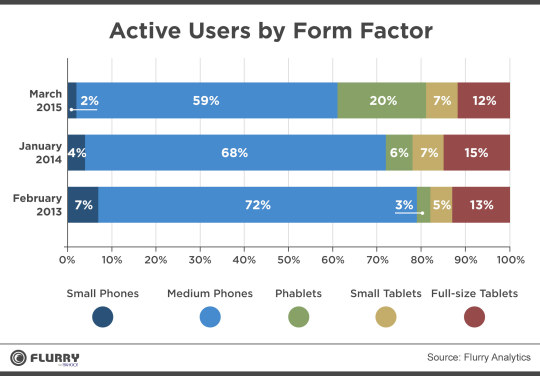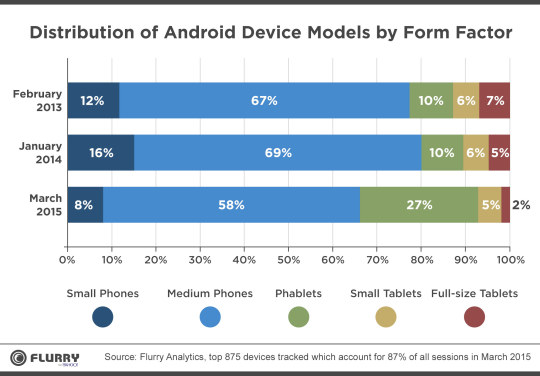April 30, 2015 | Jarah Euston
While mobile app developers have been abuzz about the launch of Apple’s smallest screen, the Watch, Flurry Analytics has seen increasing interest in one of its largest screens - the iPhone 6 Plus. Once upon a time, Steve Jobs said “no one is going to buy” a big phone, and we theorized that phablets were just a fad. Six months since the iPhone 6 Plus debut, we see the new iOS form factor has had significant impact on the global market.
To better understand the impact of the iPhone 6 Plus, Flurry from Yahoo examined the 1.6 billion devices it tracks every month to explore usage by screen size. To simplify analysis, we focused on the top 875 devices which accounted for 87 percent of sessions in March 2015. As a reminder, we categorize devices as follows:

Phablets More than Triple Share of Active Users

It seems consumers worldwide are smitten with the combination of a large screen size and good old fashioned cellular telephony. Indeed, in some early adopter markets like Taiwan and Hong Kong, the share of active users on phablets is 50 percent. Six months after the iPhone 6 Plus launch, phablets are now the second most used form factor, after medium phones (such as the iPhone 6). The growth in phablets from only a year ago is staggering: In January 2014 phablets accounted for only 6 percent of the used devices. In March 2015 the phablet share more than tripled to 20 percent! This growth has come mostly at the expense of medium phones, which lost 9 percent share in the past year. Full-size tablets and small phones also suffered losses in share while small tablets held their ground at 7 percent.
Despite Big Apple Launch, Android Continues to Lead the Phablet Revolution

Almost One-Third of Android Devices are Phablets
According to Flurry Analytics, 36 percent of active Android devices in the month of March 2015 were phablets, compared with only 4 percent on iOS. This is due to the fact that there is only one phablet by Apple, and it was just launched in September of last year. It might take some time for iOS enthusiasts to hop on the phablet bandwagon. To control for the replacement rate of devices (i.e., consumers may wait for their carrier plan to provide a device subsidy), we looked at the number of daily active users for the iPhone and the iPhone 6 Plus. Since the launch of these two devices, there have been approximately 2.75 times the number of iPhone 6s as Pluses. For iOS users, the phone is still winning over the phablet.

As the chart above shows, the number of models of Android phablets has exploded in the past two years. In 2013, only 10 percent of Android phones were phablets. By 2015, phablet share has nearly tripled to 27 percent, largely at the expense of medium phones. Android manufacturers are increasing screen sizes and introducing more and more models of phablets.
Phablets are Here to Stay
The pace of mobile growth and shifting of consumer preferences continues to be the fastest we’ve witnessed in our lifetimes. 20 percent of all active devices are now phablets, up from only 3 percent two years ago and we see no sign of this trend stopping. If there is one lesson to be learned in the phablet revolution perhaps it is this: Don’t bet against the Asian early adopter markets; they are usually onto something big.